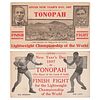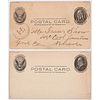Joe Gans vs. Kid Herman Lightweight Championship, Tonopah, Nevada, 1907, Fight Postcards
About Seller
6270 Este Ave.
Cincinnati , OH 45232
United States
With offices in Cincinnati, Cleveland and Denver, Cowan’s holds over 40 auctions each year, with annual sales exceeding $16M. We reach buyers around the globe, and take pride in our reputation for integrity, customer service and great results. A full-service house, Cowan’s Auctions specializes in Am...Read more
Two ways to bid:
- Leave a max absentee bid and the platform will bid on your behalf up to your maximum bid during the live auction.
- Bid live during the auction and your bids will be submitted real-time to the auctioneer.
Bid Increments
| Price | Bid Increment |
|---|---|
| $0 | $25 |
| $500 | $50 |
| $1,000 | $100 |
| $2,000 | $250 |
| $5,000 | $500 |
| $10,000 | $1,000 |
| $20,000 | $2,500 |
| $50,000 | $5,000 |
| $100,000 | $10,000 |
About Auction
Dec 3, 2020
Cowan’s Auctions is pleased to be offering Part II of the Steve Turner Collection of African Americana. Comprised of over 240 lots, this remarkable collection tells the history of African Americans, especially their role in settling the western frontier in the 19th and early 20th century. Cowan's Auctions dawnie@cowans.com
- Lot Description
Lot of 2 postcards related to the January 1, 1907 fight between Joe Gans and Kid Herman in Tonopah, Nevada, comprising:
Postcard featuring photographic portraits of Gans and Herman alongside an aerial image of Tonopah captioned "(The Heart of the Land of Gold)." Titled in red: "Spend New Year's Day, 1907 in Tonopah / Finish Fight / Lightweight Championship of the World." Postmarked the day after the fight, Jan. 2, 1907 to Mr. Frank Show (1864-1943) in McCool Junction, Nebraska. N.p., 1907.
Postcard with photographic images of Gans and Herman in fighting poses. Titled in red: "Spend New Year's Day 1907 in Tonopah (the Heart of the Land of Gold) / Finish Fight for the Lightweight Championship of the World." Postally unused. N.p., 1907.
The bout with Herman "Kid Herman" Landfield (1883-1934) was the first fight for Gans after his victory over Battling Nelson on July 4th the previous year. The Old Master would quickly best the Canadian by TKO in 8 rounds.
Joe Gans (born Joseph Gant, 1874-1910) is considered by many to be the greatest lightweight boxer ever to fight. Known as the “Old Master,” he was renowned for his scientific approach to the game. He would carefully analyze opponents, determine their weaknesses, and strike with precision. He was the first African American to hold a boxing title, becoming the Lightweight Champion in 1902, defending it successfully until 1908.
Gans began boxing in 1891 in his hometown of Baltimore. He convincingly won the World Lightweight Title in 1902 from Frank Erne. Starting in 1903, Gans began to take fights in the welterweight class and won several fights against excellent boxers including Sam Langford, Barbados Joe Walcott, Jack Blackburn, and more. Indeed, by modern record-keeping standards, Gans would have been considered welterweight champion. Welterweight was not a marquee class in this period, however, and did not earn large purses. There were several pretenders to the title who claimed that Gans had “abandoned” the title by fighting in the welterweight division. By 1905, Gans was without a manager and dire straits financially. It was in this atmosphere that his most important title defense came with a blockbuster fight against Oscar “Battling” Nelson in the gold rush boomtown Goldfield, Nevada on September 3, 1906.
The fight was organized by Tex Rickard as a way to provide an influx of cash for the town. He capitalized on the controversy that now existed in the Lightweight title, as Nelson was claiming the title. In 1904, Gans had successfully defended his title in 1904 against Jimmy Britt, but a brawl erupted after the bout and Britt would claim later that year that he won the title. Bolstered by Gans fighting in the welterweight class, Nelson then claimed the crown when he knocked out Britt in September 1905. Rickard saw a golden opportunity to “settle the debate” and profit on the results.
Gans was desperate for any fights in 1906 and agreed to an unequal share of the purse as well as conditions set by Nelson. Notably, Nelson insisted on an unheard-of three weigh-ins before the fight. Making weight was a concern for Gans as he needed to shed several pounds from his forays into the welterweight class, a task that would tax his body. By requiring three weigh-ins, it meant that Gans would be unable to eat properly before the fight.
The fight went an astonishing 42 rounds in the Nevada sun. Nelson was continuously warned for headbutting and hitting below the belt, with the fight often devolving into wrestling. Though the “Durable Dane” was living up to his nickname, the champions tired in the Nevada heat, and Gans was getting the best of Nelson knocking him down more than once, and helping him up each time. In the 42nd, Nelson landed an illegal hit below the belt sending Gans to the canvas. The referee immediately declared Gans the champion. He would take his winnings and open the Goldfield Hotel in Baltimore.
The Goldfield fight proved to be the pinnacle of his career, as he would succumb to tuberculosis. While no clear diagnosis exists, many historians speculate that he already was infected at the time of his first fight with Nelson, possibly as early as 1904. Gans would continue to successfully defend his title the next two years with his last successful fight against Rudy Unholz on May 14, 1908. Later that year, when he was decidedly suffering from the effects of tuberculosis, he would lose the title in a rematch with Nelson in Colma, California on July 4 and again on September 9. He would die at just 35 on August 10, 1910. Today, a statue of Gans graces the lobby at Madison Square Garden and is rubbed by modern boxers for good luck.Light toning.Condition
- Shipping Info
-
SHIPPING & PICKUPS Cowan’s Cincinnati Office offers an in-house, full-service shipping department which is unparalleled in the auction industry. Shipping costs are provided with your finalized invoice 24-48 hours after auction. For furniture and oversized items, we recommend using third-party services. For more information, contact cowansshipping@hindmanauctions.com. NOTE: All pickups and preview are by appointment only. To make an appointment, please call 513-871-1670 or email cincinnati@hindmanauctions.com Buyers are required to pay for all packing, shipping and insurance charges. Overseas duty charges are the responsibility of the successful Bidder. Be aware that for larger and/or valuable items, shipping charges can be substantial. - Shipping charges include insurance for your order while in transit. If you have private insurance we will adjust your charge to include only packing and shipping. - Please allow 14 – 21 days after payment to package and ship your purchase as carefully as possible.
-
- Buyer's Premium



 EUR
EUR CAD
CAD AUD
AUD GBP
GBP MXN
MXN HKD
HKD CNY
CNY MYR
MYR SEK
SEK SGD
SGD CHF
CHF THB
THB












